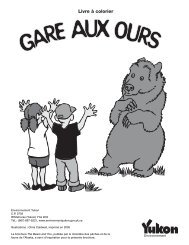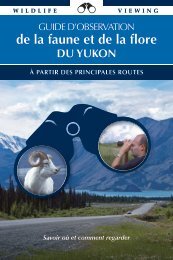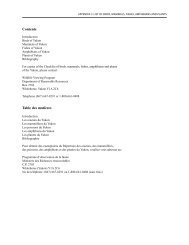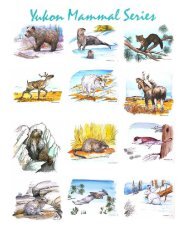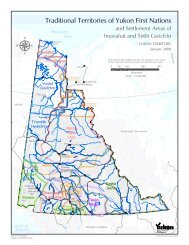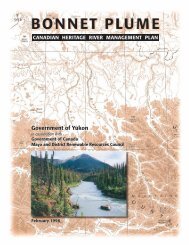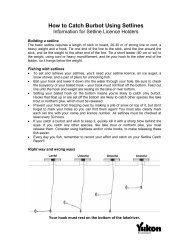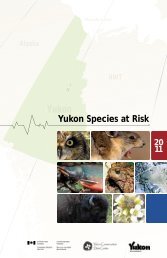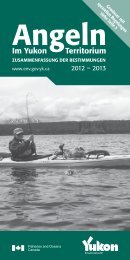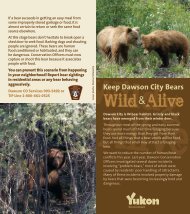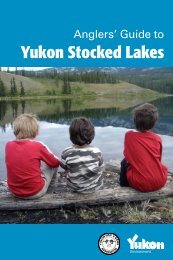Ch. 3 Land - Environment Yukon
Ch. 3 Land - Environment Yukon
Ch. 3 Land - Environment Yukon
Create successful ePaper yourself
Turn your PDF publications into a flip-book with our unique Google optimized e-Paper software.
every year in the <strong>Yukon</strong>, but the annual<br />
special waste collection alone removes<br />
25 tonnes. This amount does not<br />
include the special wastes treated or<br />
disposed of in the <strong>Yukon</strong>, or the special<br />
wastes shipped independently of the<br />
<strong>Yukon</strong> government collection system. If<br />
national estimates of special waste<br />
generated per capita are applied to the<br />
<strong>Yukon</strong>, we probably produce about<br />
100 tonnes of special waste per year in<br />
the territory.<br />
When these wastes are not handled<br />
in a responsible way, the environment<br />
and human health can suffer. Because<br />
of a lack of money and poor<br />
understanding of the consequences,<br />
many kinds of special wastes have been<br />
treated like everyday garbage in the<br />
past. This has caused:<br />
■ groundwater contamination by<br />
leachate (the liquid that seeps<br />
through the waste);<br />
■ surface water contamination<br />
through run-off from precipitation<br />
and snowmelt, and contact with<br />
contaminated groundwater;<br />
■ local air pollution because of<br />
open burning and evaporation;<br />
■ soil contamination;<br />
Household<br />
hazardous<br />
waste 1%<br />
Solid waste<br />
30%<br />
Recyclable<br />
materials 20%<br />
Compostable<br />
materials 49%<br />
Figure 3.13 Current composition of<br />
Whitehorse waste<br />
This figure shows the composition of<br />
the waste stream in Whitehorse, not the<br />
composition of the landfill. As shown,<br />
69 per cent of Whitehorse waste could<br />
be recycled or composted.<br />
■ direct poisoning or injury to<br />
people and wildlife exposed to<br />
the waste;<br />
■ food web poisoning; and<br />
■ fires and explosions.<br />
Cleaning up a site after it has been<br />
contaminated is both expensive and<br />
dangerous. Managing special and<br />
hazardous wastes has become a<br />
priority for all of us because of these<br />
potential problems. Now a special<br />
waste permit under the Special Waste<br />
Regulations is required to generate,<br />
collect, or dispose of special wastes.<br />
Special waste is a harmful substance<br />
that requires special management and<br />
cannot be discarded without risk to<br />
public health and the environment. The<br />
federal Canadian <strong>Environment</strong>al<br />
Protection Act (CEPA) defines many<br />
substances that require special handling.<br />
Under the <strong>Yukon</strong> government’s<br />
Dangerous Goods Transportation Act,<br />
dangerous goods are defined as<br />
materials that have an inherent hazard.<br />
Oven cleaner and varsol are two<br />
examples of dangerous goods. When<br />
the time comes to dispose of these<br />
products, they are then classified as<br />
special wastes.<br />
Types of waste<br />
In our throw-away society, we produce<br />
many different types of solid waste.<br />
Figure 3.13 shows the basic components<br />
of solid waste in Whitehorse<br />
garbage and Figure 3.15 shows landfill<br />
volumes. Waste could be reduced<br />
significantly with greater composting<br />
and recycling.<br />
How are we managing solid<br />
waste?<br />
Solid waste is the everyday garbage<br />
that goes to the local dump. It can<br />
come from residential, commercial,<br />
industrial, or other human related<br />
activities or sources; and include<br />
everything from ashes, domestic<br />
garbage, compost, vehicle hulks, and tin<br />
cans to plastic containers and old tires.<br />
It also includes waste generated by the<br />
demolition or construction of buildings<br />
or other structures.<br />
Solid waste does not normally include<br />
waste from industrial activities like<br />
mining or hazardous materials that are<br />
harmful to the environment and require<br />
special handling. These are called<br />
special wastes.<br />
Waste disposal practices now<br />
Most solid waste in the <strong>Yukon</strong> is disposed<br />
of in 26 waste sites located in or<br />
near communities (Figure 3.14). The<br />
<strong>Yukon</strong> Department of Community and<br />
Transportation Services manages 19 of<br />
these sites, while the rest are the<br />
responsibility of incorporated municipalities.<br />
Rural communities are served<br />
either by a municipal dump or by a<br />
<strong>Yukon</strong> government site.<br />
All solid waste disposal sites managed<br />
by the territorial government are operated<br />
according to the Solid Waste Management<br />
Procedures and Guidelines,<br />
updated in March 1996. In addition to<br />
the 26 managed sites, the many abandoned<br />
and unregulated garbage dumps<br />
in the <strong>Yukon</strong> are regularly being<br />
assessed and cleaned up.<br />
At most <strong>Yukon</strong> garbage dumps, waste<br />
is thrown into an excavated trench or<br />
natural depression where it is<br />
periodically compacted and burned.<br />
When the trench is filled to its capacity<br />
it is covered with soil. Most of these<br />
areas hold less than 30 cubic metres of<br />
garbage and last about five years.<br />
Solid Waste Disposal regulations<br />
adopted in 2000, will affect how<br />
garbage is handled and waste sites are<br />
developed in the future.<br />
We now know that there are costs<br />
associated with the dumping of solid<br />
waste. The City of Whitehorse Solid<br />
Waste Action Plan outlines the many<br />
direct and indirect costs associated<br />
with waste disposal 3.<br />
C H A P T E R 3 L A N D ❧ 5 3






